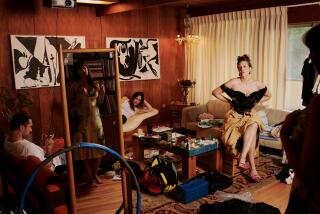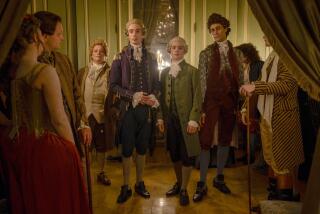As ‘The Marvelous Mrs. Maisel’ returns for Season 2, we go behind the scenes of those amazing sets
As it moves from the Upper West Side of Manhattan to the Catskills and Paris, the second season of Amazon’s hit comedy “The Marvelous Mrs. Maisel” continues to transport viewers to another time — 1959 — courtesy of its flawless midcentury sets.
With their towering table lamps and Hollywood Regency sideboards, the sets on the Emmy-winning series rival the most sardonic lines delivered by comedian Midge (Rachel Brosnahan) and her manager Susie (Alex Borstein).
Just don’t tell that to “Maisel” production designer Bill Groom.
“Someone once said that scenery is not to be noticed; it is to be forgotten,” said Groom. “That’s our goal.”
Working with set decorator Ellen Christiansen, Groom said it is their job to move the story along by creating sets that are “comfortable and real and settle into the story.”
In recent interviews, Groom and Christiansen answered questions about how they construct the show’s striking apartments, where they find inspiration and how the show’s characters influence their designs. Season 2 premieres Dec. 5.
Without revealing any spoilers, how is the second season different?
Groom: It’s just like when you spend time with friends and family: As the season goes on and the years go by, you’ll get to know the characters better. My job is to express all of that visually.
Christiansen: Midge’s world is expanding. She is making more opportunities for herself and is opening herself up to new challenges. Her life has exploded into something else, yet she is embracing it and becoming more comfortable and adventurous.
Each character has such a distinctive space. How does personality influence their room decor?
Groom: It’s everything. All of our choices are based on the characters we are seeing. I’ve said many times that for me, personally, the most exciting part of this process is the discovery of any story.
Christiansen: Everybody has a sensibility — colors they like and don’t like. Some things are more masculine than others. Even the offices. Each club and bar has its own personality. We want people to know the neighborhood. Midtown. Downtown. It goes back to Midge being an uptown girl. We always want to show that contrast.
Groom: The clubs are an important element in her journey. It’s something we’ve tried to stay focused on. The Gaslight Cafe in Manhattan [where she performs] was a real place and still exists. We found as many pictures of it as we could to re-create it.
What reference materials did you use for the sets?
Groom: We have all kinds of sources. It can be anything from books and photos we might find at the Library of Congress to something as simple as a product brochure. I prefer to work from things of the period rather than about the period. A lot of research happens on location scouts where we might spot architectural details. We are often asked about the color palette for the show. It’s interesting to me that people are so fascinated by that. We have paint samples from the period that we use.
How would you describe the Weissmans’ apartment?
Groom: It’s an Upper West Side apartment building. In its day it was one of the nicer buildings. It is typical of what was built at the turn of the [last] century. Today, it requires quite a lot of money to have a place like that, but at the time, the apartments were built for families with five or six bedrooms that went on forever. We’re trying to stay true to that.
Christiansen: I was not on the pilot, but they shot it in an Upper West Side location. For the first season we fleshed it out. We added the kitchen and the kids’ room and expanded some things. They are sets. But the architecture is based on a real place.
In the first season, Susie is overwhelmed by Midge’s apartment. “Where the hell are we?” she asks. “Versailles?” Which came first: the punchline or the set?
Groom: That probably came after the set. As the seasons go by you’ll get to know the characters a little better and understand why their apartments are the way they are.
How did you decide on the style of furniture?
Christiansen: I start with the script and the characters. It’s not just me. Everyone weighs in. I ask myself, “What would these people have?” I read the script, see the casting and think, “If I were this person, with this background, what would I have?” For me, it’s more about going out and looking and seeing something and thinking, “That’s Abe’s chair.” Everyone has their own style.
Were you trying to avoid looking like “Mad Men,” which also takes place in New York during the 1950s?
Groom: Maybe a little bit. But not at the expense of the show. I wanted to create a real environment. On “Mad Men,” I think they intentionally pushed the midcentury modern look as a metaphor for the show and its environments.
Christiansen: I think that was a different kind of world. That was a business world.
The wall coverings and textiles are so evocative of the period. Are they vintage?
Christiansen: We always try to get vintage wallpaper for some things but often there just isn’t enough. We can have some things digitally reproduced. I use the Decoration & Design Building in New York City as a resource, and there are many companies that make patterns that are 100 years old and have that sensibility. Sometimes it works better because it’s a little fresher.
Are you going for a period piece or a timeless feel?
Christiansen: In any place, you walk in and see things that are old, new and 10 years old. It has to be a mix.
Where do you shop for the accessories?
Christiansen: I shop a lot in the Hudson Valley. The Berkshires. All over Connecticut. Sometimes the Brimfield Antique Show. I love thrift shops. I can’t not go in. I have great people working for me who are shoppers. People are always looking out for us. It’s like a constant surveillance. It’s a mix of vintage and reproduction. There is a great dealer of old vintage appliances in Ohio where we source a lot of the sinks and tubs and bathroom appliances. All of the appliances are old. We spruce them up and have things resurfaced. We have been pretty lucky with finding vintage things and touching them up. The scenic department can help us fix broken legs and create movie magic.
How closely do you work with the creator on your design decisions?
Groom: Amy [Sherman-Palladino] and Dan [Palladino] are both great. They are organic. They have specific ideas, and they respond to the actors as their characters. They are both collaborative, which is great. Everybody on the show feels a part of the creative process.
Christiansen: Amy and Dan are really involved. We have a language. They want to know what is going on. We don’t sit and show them every teaspoon. If there is a question I will ask them, “Is that what you were thinking?” If something is off, they’ll notice. We can’t slide by. That’s why I like working on this show. I have pretty high standards and so does everyone else, from the electricians to the grips. Everyone cares.
ALSO:
‘The Crown’ production designer Martin Childs shares how he creates those lavish sets
A Spanish-style hacienda so inviting, it has a starring role in the film ‘Home Again’
Here’s what to expect when ‘The Marvelous Mrs. Maisel’ returns for its second season
More Southern California home tours



